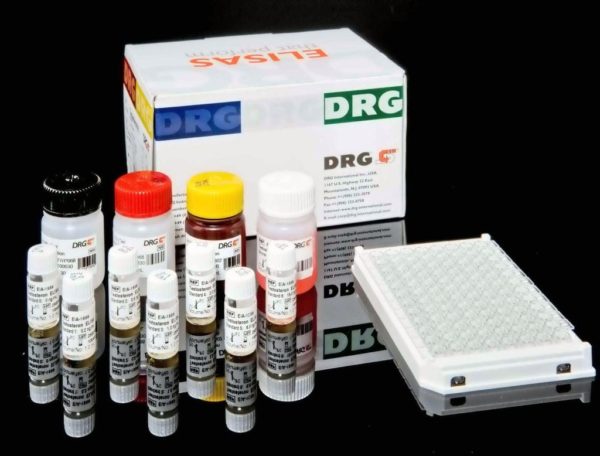Description
The DRG:HYBRiD-XL freeT4 is an enzyme immunoassay for the quantitative in vitro diagnostic measurement of free Thyroxine (fT4) in serum and plasma.
Only for use with the DRG:HYBRiD-XL Analyzer.
L-Thyroxine (T4) or 3,5,3Õ,5Õ-tetraiodothyronine is synthesized by the thyroid gland and is secreted into the bloodstream (1). Here T4 becomes bound to serum transport proteins leaving only about 0.03% free T4 (fT4). The major transport protein is Thyroxine Binding Globulin (TBG) which normally accounts for 70% of the bound T4. Other thyroid
hormone binding proteins are Thyroxine Binding Prealbumin and Albumin (2).T4 has its primary influence on protein synthesis and oxygen consumption in virtually all tissues but it is also important for growth, development, and sexual maturation (3). The thyroid gland is regulated by thyrotropin releasing hormone (TRH) and thyroid stimulating hormone (TSH). In addition to TRH/TSH regulation by thyroid hormone feedback, there is central modulation by nutritional signals, such as leptin, as well as peptides regulating appetite. (4). Measurement of fT4 concentration is considered to be a valuable parameter if TSH concentration is out of normal range. Since fT4 represents the metabolically active fraction of T4 in serum, it reflects the actual hormone production of the thyroid gland. Primary hypothyroidism results in underproduction of T4 by the thyroid gland and consequently an abnormally low circulating fT4 concentration in the blood (5). Primary hyperthyroidism leads to excessive thyroid production of T4 and resulting elevated fT4 concentration (6).
The DRG:HYBRiD-XL freeT4 Kit is a solid phase enzyme-linked immunosorbent assay (ELISA) based on the principle of competitive binding. The antibody coated wells (ACW) of the reagent cartridges are coated with a monoclonal (mouse) antibody directed towards a unique antigenic site of the free T4 molecule. Endogenous free T4 of a patient sample competes with a T4-horseradish peroxidase conjugate for binding to the coated antibody. After incubation the unbound conjugate is washed off. The amount of bound peroxidase conjugate is inversely proportional to the concentration of free T4 in the sample. Having added the substrate solution, the intensity of colour developed is inversely proportional to the concentration of free T4 in the patient sample.




